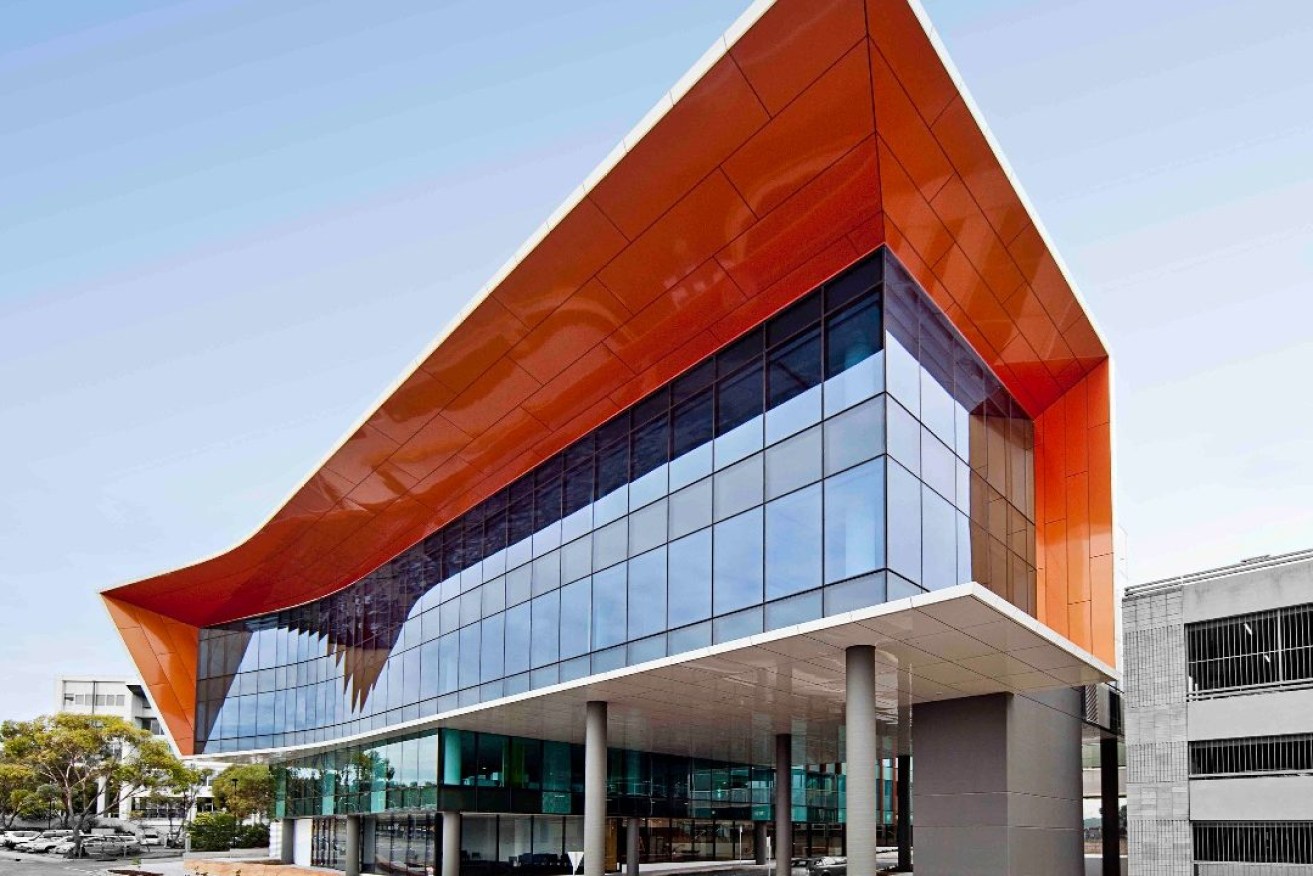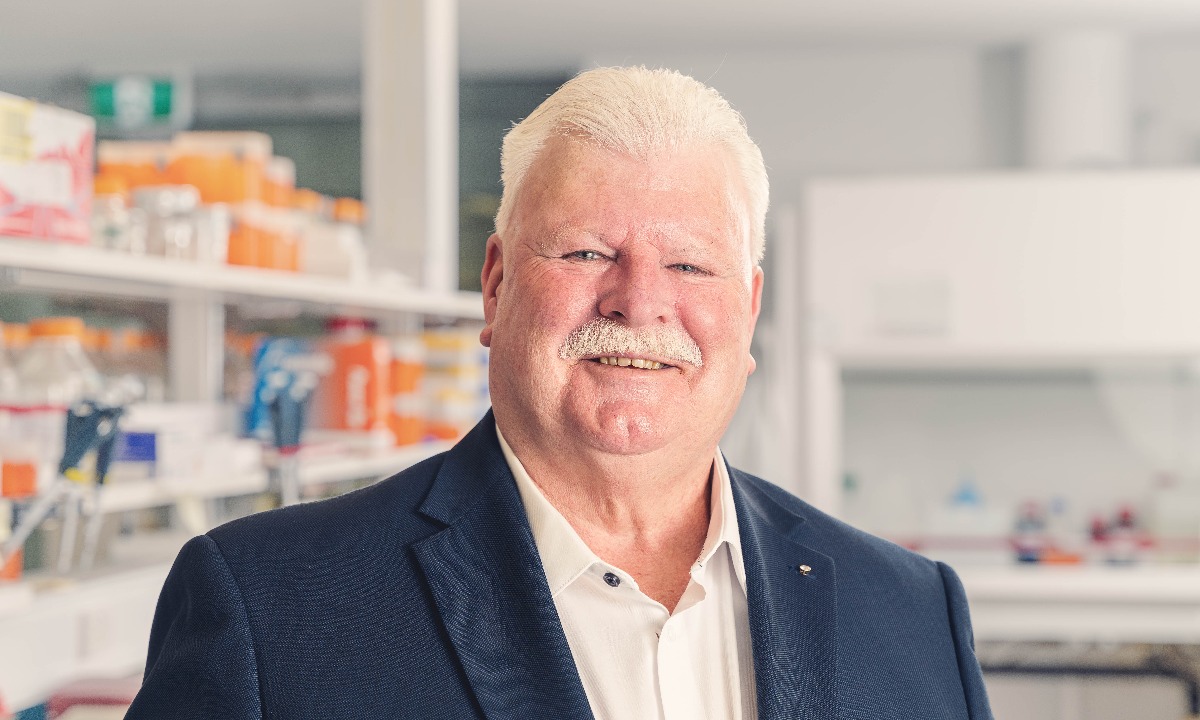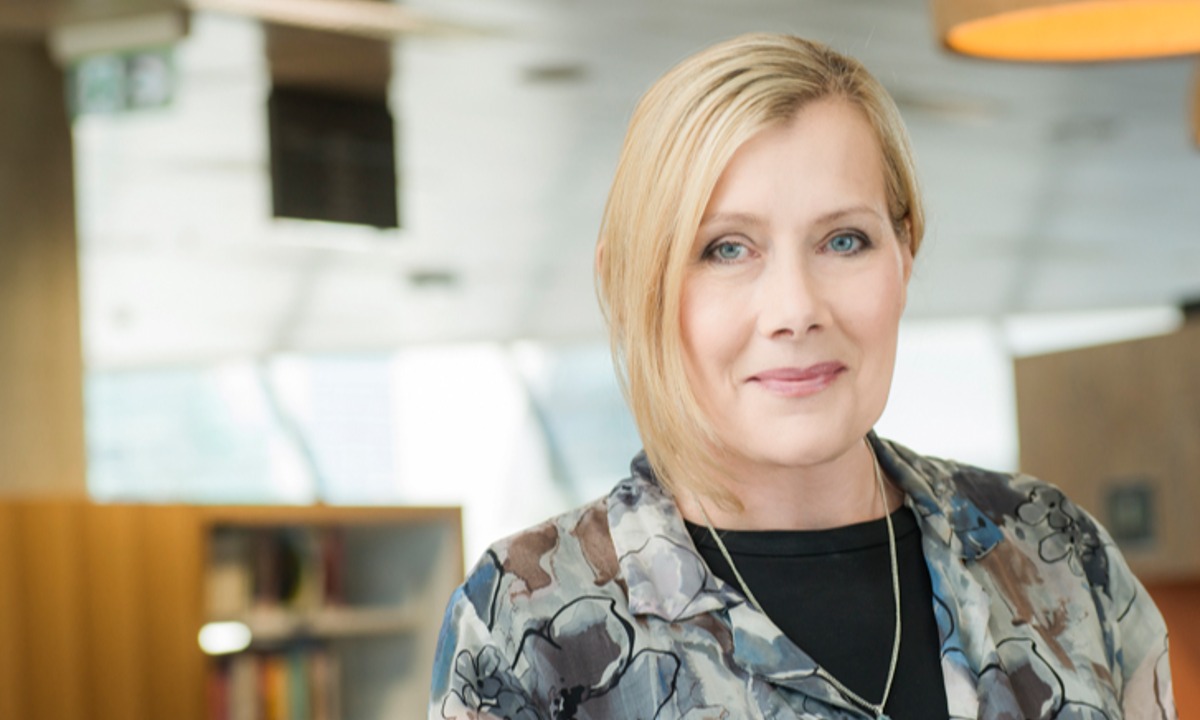Faces of Flinders: Foundations
To celebrate the 10-year anniversary of the Flinders Centre for Innovation in Cancer, we present some of the faces behind this life-changing initiative, including two people integral to the founding of the centre: Alan Young and Deborah Heithersay.

Flinders Centre for Innovation in Cancer.
A heart of gold
In the boardroom of his stockbroking firm overlooking Victoria Square, Alan Young AM quips that he welcomes the day when the cancer centre he grew from the ground up becomes an art gallery because the war on cancer would be won.
Realistic that “that will never happen”, the long-time chair of the Flinders Foundation and chair of Solstice Media (publisher of InDaily) says the end game is for South Australians to live healthier, happier and longer lives with the people they love.
It’s a powerfully simple statement spoken in earnest from a boy from Broken Hill whose reason for being is to help the people who offer a beacon of hope and a path to healing in the patient journey.

Alan Young is a co-founder of the Flinders Foundation.
His vision became reality 10 years ago with the opening of the Flinders Centre for Innovation in Cancer (FCIC), South Australia’s first integrated cancer centre combining world-class compassionate care and survivorship with groundbreaking prevention and early intervention research.
“It was driven by a passion, a vision and an obsession for our community to have happier and longer lives to spend with the people they love, that’s the 30,000-foot level,” Young says.
“It’s the patient who’s the pre-eminent person in this journey, they’re the reason we do what we do,” he says.
Laying the foundations
As co-founder of the Flinders Foundation, Young has been instrumental in joining the forces of Flinders University’s sharpest scientific minds with Flinders Medical Centre’s leading health experts to “break the back” of one of humankind’s most insidious diseases.
It all began when a client invited him to Flinders “to have a look”.
At the time, the uniqueness of the Flinders footprint was its own worst enemy.
“The problem was you had a university, a hospital and research people who worked either for the hospital or the university, and some worked for both. And it was pretty hard to tell who was doing what.
“So my idea was very simple. Let’s establish, let’s found, a single foundation whose role it will be to fund health and medical research, patient care and medical teaching for the whole of the Flinders campus – the village that is the hospital and the university.
“And that’s how we began.”
Strength in numbers
Just a few years after the Foundation was established, it spearheaded the massive $30 million fundraising campaign that – a decade later – eventuated in the opening of the four-storey FCIC in 2012, perched on a hill between the hospital and university.
“We know that all of those stakeholders together are much more powerful than they are alone,” Young says.
“So we thought let’s create a cancer centre which puts the researchers, the clinicians, the surgeons, the medical practitioners and the patients under the one roof.
“Let’s focus on the whole person and not just treat the disease because cancer is shockingly disruptive and can decimate a person’s life so you need to treat the whole person, not just the disease.”
The first ship in the fleet
Housing the state’s first and only dosing machine – a milestone in precision medicine – along with Australia’s first survivorship program that’s now copied throughout the country, the FCIC represents a flagship model for integrated cancer care, research and wellness.
In the decade since the inception of FCIC, Flinders Foundation has funded 120 cancer-related projects totalling $40 million, including the build.
“We didn’t just build a building, put some people in there and say, ‘off you go, we’ll be back in 10 years to see how you’re doing’,” Young says.
“We’ve constantly funded and grown in our commitment to the process and it’s not only spread throughout the Flinders village but beyond that to the rest of Adelaide.
Though the fight, he says, is far from over.
“I like to think of it as our first ship in a fleet.
“We built it, it works, we sailed it around the world and now we need to make it bigger or make more of them. One way or another. That’s what we aim to do.”
Sliding doors
In the years preceding the FCIC’s completion, with the “bottom falling out of the economy” thanks to the Global Financial Crisis, the Foundation fought a tooth-and-nail fundraising battle.
“Once the GFC hit people were only focused on financial survival, they certainly didn’t have the money or the inclination to be donating to just about anything,” Young says.
“Whereas governments might have been worried if people were sick, now they were worried about how they going to survive financially. So it wasn’t about beds, it was about bread.”
In a sliding door moment to top all sliding door moments, Young was invited to dinner with former Federal Health Minister Tony Abbott. As luck would have it, they sat shoulder-to-shoulder in a serendipitous circumstance that would shape the future of cancer at Flinders.
“I leant over to him at one stage and said, ‘listen, I’ve got a problem, we want to build this cancer centre and I need you to give us $10 million and we’ll raise the rest’,” Young says.
FCIC turned out to be the only project funded for South Australia when the Federal budget was handed down the following year.
The State Government later contributed $5 million, with funds from Flinders University, the Australian Cancer Research Foundation, Cancer Council SA and millions of dollars of public donations enabling the building to rise from the ground.
Unsung heros
A man who doesn’t dwell on the past, Young reflects on the last decade of the Flinders success story with a mixture of pride and admiration.
“I do sometimes ask myself, project-by-project, whether that time was well spent. Because you’ve only got so much time in your life, right?
“And I’ve got to say that my time at Flinders has been among the best spent time of my life and I’m very grateful for having had the opportunity to contribute.
“But I’m not the hero, the Foundation is not the hero. The heroes are the patients who go through this journey and the researchers and clinicians who work so hard to help others and put themselves at risk, as we saw in the recent pandemic.
“It’s a special sort of person who does that, and the fact that I’ve been allowed to help them and work with them is an absolute privilege.”
Foundations of Strength

Deborah Heithersay
Like the very lives it touches, the story of the Flinders Centre for Innovation in Cancer (FCIC) includes one woman’s unwavering strength, courage, and perseverance.
That woman is Deborah Heithersay – one of the most instrumental and pivotal parts in the making of South Australia’s first integrated cancer centre delivering world-class patient care and survivorship alongside prevention and early intervention research.
Her relationship to the Centre began back in 2000. Living in Sydney, she was headhunted by Flinders Foundation chair Alan Young to be a consultant on the project; a very personal project having lost her mother to the disease.
And like all things worth doing, they take time – 13+ years in fact, from conception to completion. In that time Deborah and her village have lobbied, campaigned, crusaded and (sometimes) begged to raise $30m worth of funding for a building that truly saves lives.
It’s fair to say Deborah, like the very patients who walk through the four-storey glass atrium of the FCIC, used every fibre of inner strength, resilience and determination to get it to where it is today.
“The project I was given was initially a lot smaller than the cancer centre you see now,” Deborah, who was CEO of the Flinders Foundation from 2000 to 2013, recalls.
“It didn’t take me long to realise a few things needed to be adjusted. One; the proposed building was at the back of Flinders Medical Centre, so no one would see it, and two; it didn’t incorporate patient care, and this was something I felt it needed to make the project more appealing to donors.
“As I had also been asked to fundraise to support the renovation of Ward 5G, the cancer ward, and the chemotherapy suite, I thought a bigger building could incorporate the chemotherapy suite and the clinic. That way, patients could benefit from the new building and a more inspiring, uplifting environment for treatment.
“So I started convincing the board that we should consider a much bigger building and take on a bigger vision, and thankfully the board members were supportive. The board was a critical part of the FCIC’s success because it gave me the freedom to take a few risks and to use the momentum of the vision to garner the support we needed every step of the way.
“At that stage we had a $1 million commitment from the State Government and the smaller building was tipped to cost about $6 million,” she says.
The bigger the better
A great admirer of the adjacent Flinders Private Hospital, Deborah approached Woodhead International designers to apply their signature stylish design to the FCIC. She also asked them to do it for free!
Fortunately, they were taken by the challenge of the complex architectural brief to design an integrated research facility at the cutting-edge of cancer research with a place of healing, wellbeing and hope.
“Not only did Woodhead agree and provide free architectural drawings, which was hours and hours of work, they also created a model, which I think I carried around for 10 years.”
“A testament to their work, the building as it now stands is close to the original design,” Deborah says.
Carparks and helicopters
The prominent hillside presence of the FCIC, which sits adjacent to the ambulance ramp leading up to Flinders Medical Centre’s (FMC) Emergency Department, was no easy feat to achieve.
Wondering where she could “find a place to put this thing”, Deborah approached the hospital’s then operations manager, Chris Ford, for advice.
“We wanted it up front, but the hospital has a very tight footprint.
“Chris said the only place that wasn’t earmarked for extension was this tiny carpark next to the emergency ramp, but if we were going to build on a carpark, we’d need to replace the parks.
“I thought ‘okay, that’s a challenge’.”
Once the location was sorted, the next hurdle Deborah overcame was that of the hospital’s helipad.
“The man who controlled the emergency services at FMC came into my office and said ‘Deb, I hear you’re building a building on this carpark – you can’t put a building on there because my helicopter is going to run into it’.
“As the emergency helicopters landed on the top carpark, I said ‘if I build a new helipad on the cancer centre can have your car parks’? He said done deal.”
Notwithstanding an abundance of meticulous planning and preparation, the creation of the Centre had its fair share of serendipity too.
“Before the new helipad was built, the helicopter landed on the carpark and in the rain and hail nurses and doctors would run out with umbrellas to cover patients on the trolley as they trekked across the carpark, across a bridge and into the hospital.
“By building the helipad on the cancer centre, we were able to design a lift and a corridor all undercover, straight through to emergency.
“It was perfect in my mind because we weren’t just building a brilliant cancer centre, we were also making the most extraordinary enhancement of the emergency services at Flinders.”
And despite her fear of heights, Deborah made the first test landing on the helipad.
“All my staff said ‘oh, don’t be such a wuss, get on that helicopter’. So I flew in the helicopter.
“I’ve got to say, I loved it because you could see the old grey carpark they used to land on and think how safer this bright green helipad is for everyone concerned.”
Lobbying, lobbying and… more lobbying
Back when the centre was still a dream with a few million dollars behind it – including a State Government pledge of $2 million and a $1 million grant from the Australian Cancer Research Foundation – Deborah garnered the support of 2013 SA Scientist of the Year Professor Graeme Young and survivorship expert Professor Bogda Koczwara to make the vision a reality.
Professor Young later went on to become the inaugural FCIC Governing Council Chairman and Director while Professor Koczwara, FMC’s former head of medical oncology, established the Centre’s world-leading survivorship focus.
“I remember I was on the plane with Graeme on our way back from Canberra and I was saying they’re not listening when we talk about an integrated centre but they do start listening when you talk about cancer prevention, which is of course Graeme’s specialty.
“At the time we were competing against a number of cancer centres that were asking to be funded so that became our point of difference.”
Federal MP Andrew Southcott then stepped in and helped Deborah “speak to the right people” in Canberra. She says he was pivotal in attracting the $10 million Federal contribution to the Centre.
“Graeme, Andrew, Alan and I were doing all the rounds of lobbying. It was coming up to the next budget and I had this feeling that things were going cold. I rang a friend who was acting as a mentor and he said ‘keep going Deb, don’t take no for an answer’.
“I picked up the phone and called former Federal member Kym Richardson and said you have to talk to your party and make this happen because this needs to happen. He added his voice to cause and we then saw the announcement – we had $10 million in Federal funding allocated in the 2007/08 budget.”
The Foundation later managed to secure a $5 million loan from the State Government, as well as two separate $2 million contributions from Flinders University and Cancer Council SA.
The window of opportunity
The Foundation’s first major fundraising campaign, the Windows of Opportunity, was launched in 2002.
It meant that families or individuals who donated more than $250 to the Centre would have their family’s name or the name of a loved one written on the glass atrium entrance of the building.
Intended as a lasting memorial to the donors and supporters of the Centre, Deborah remembers people walking in with generous donations.
“Every day I would drive to work and visualise that cancer centre.
“There were moments when I felt like giving up, that my career would be over because I couldn’t achieve this huge feat. But then something would happen, someone would come in with some money.”
A lasting legacy
Throughout the long and often bumpy road to create the FCIC, Deborah has lost many friends and faces to cancer.
In all the flutter of the FCIC – from the first time Alan Young announced at the Foundation’s Pink Yellow Blue Ball that it would actually be built, to the turning of the sod and the support of cancer survivor Lance Armstrong’s LIVESTRONG – Deborah says it’s “nothing compared to knowing you’ve been able to serve people”.
“I’ve met so many beautiful families, obviously everyone’s touched by cancer.
“They share their story and you feel very humbled by the fact they’re sharing what is often their heartache with you.
“It’s one of the privileges of working in fundraising because people are trying to transform a tragedy into something positive.”





